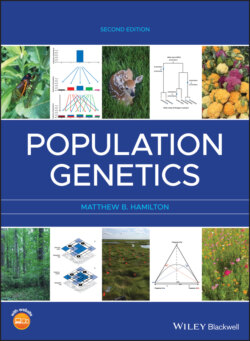Читать книгу Population Genetics - Matthew B. Hamilton - Страница 35
Box 2.2 Protein locus or allozyme genotyping
Оглавление
Determining the genotypes of individuals at enzymatic protein loci is a rapid technique to estimate genotype frequencies in populations. Protein analysis was the primary molecular genotyping technique for several decades before DNA‐based techniques became widely available. Alleles at loci that code for proteins with enzymatic function can be ascertained in a multi‐step process. First, fresh tissue samples are ground up under conditions that preserve the function of proteins. Next, these protein extracts are loaded onto starch gels and exposed to an electric field. The electrical current results in electrophoresis where proteins are separated based on their ratio of molecular charge to molecular weight. Once electrophoresis is complete, the gel is then “stained” to visualize specific enzymes. The primary biochemical products of protein enzymes are not themselves visible. However, a series of biochemical reactions in a process called enzymatic coupling can be used to eventually produce a visible product (often nitro blue tetrazolium or NBT) at the site where the enzyme is active (see Figure 2.11). If different DNA sequences at a protein enzyme locus result in different amino acid sequences that differ in net charge, then multiple alleles will appear in the gel after staining. The term allozyme (also known as isozyme) is used to describe the multiple allelic staining variants at a single protein locus. Allozyme electrophoresis and staining detects only a subset of genetic variation at protein coding loci. Amino acid changes that are charge neutral and nucleotide changes that are synonymous (do not alter the amino acid sequence) cannot be detected by allozyme electrophoresis methods. Refer to Manchenko (2003) for a technical introduction and detailed methods of allozyme detection.
Figure 2.11 An allozyme gel stained to show alleles at the phosphoglucomutase or PGM locus in striped bass and white bass. The right‐most three individuals are homozygous for the faster migrating allele (FF genotype), while the left‐most four individuals are homozygous for the slower migrating allele (SS genotype). No double‐banded heterozygotes (FS genotype) are visible on this gel. The + and – indicate the anode and cathode, respectively, ends of the gel. Wells where the individual samples were loaded into the gel can be seen at the bottom of the picture. Gel picture kindly provided by J. Epifanio.
(2.12)
where k is the number of alleles at the locus, the pi 2 and 2pipj terms represent the expected homozygote genotype frequencies with random mating based on allele frequencies, and indicates summation of the frequencies of the k homozygous genotypes. Under random mating, . This quantity was called the gene diversity by Nei (1973) to distinguish it from the heterozygosity when there is non‐random mating within populations and to recognize that it is a quantity that can be applied to polyploids (see Meirmans et al. 2018). The expected heterozygosity can be adjusted for small samples by multiplying He by 2N/(2N − 1) where N is the total number of genotypes (Nei and Roychoudhury 1974), a correction that makes little difference unless N is about 50 or fewer individuals. In a similar manner, the observed heterozygosity (Ho) is the sum of the frequencies of all heterozygotes observed in a sample of genotypes:
(2.13)
where the observed frequency of each heterozygous genotype Hi is summed over the h = k(k − 1)/2 heterozygous genotypes possible with k alleles. Both He and Ho can be averaged over multiple loci to obtain mean heterozygosity estimates for two or more loci. Heterozygosity provides one of the basic measures of genetic variation, or more formally genetic polymorphism, in population genetics.
The fixation index as a measure of deviation from expected levels of heterozygosity is a critical concept that will appear in several places later in this text. The fixation index plays a conceptual role in understanding the effects of population size on heterozygosity (Chapter 3) and also serves as an estimator of the impact of population structure on the distribution of genetic variation (Chapter 4).
